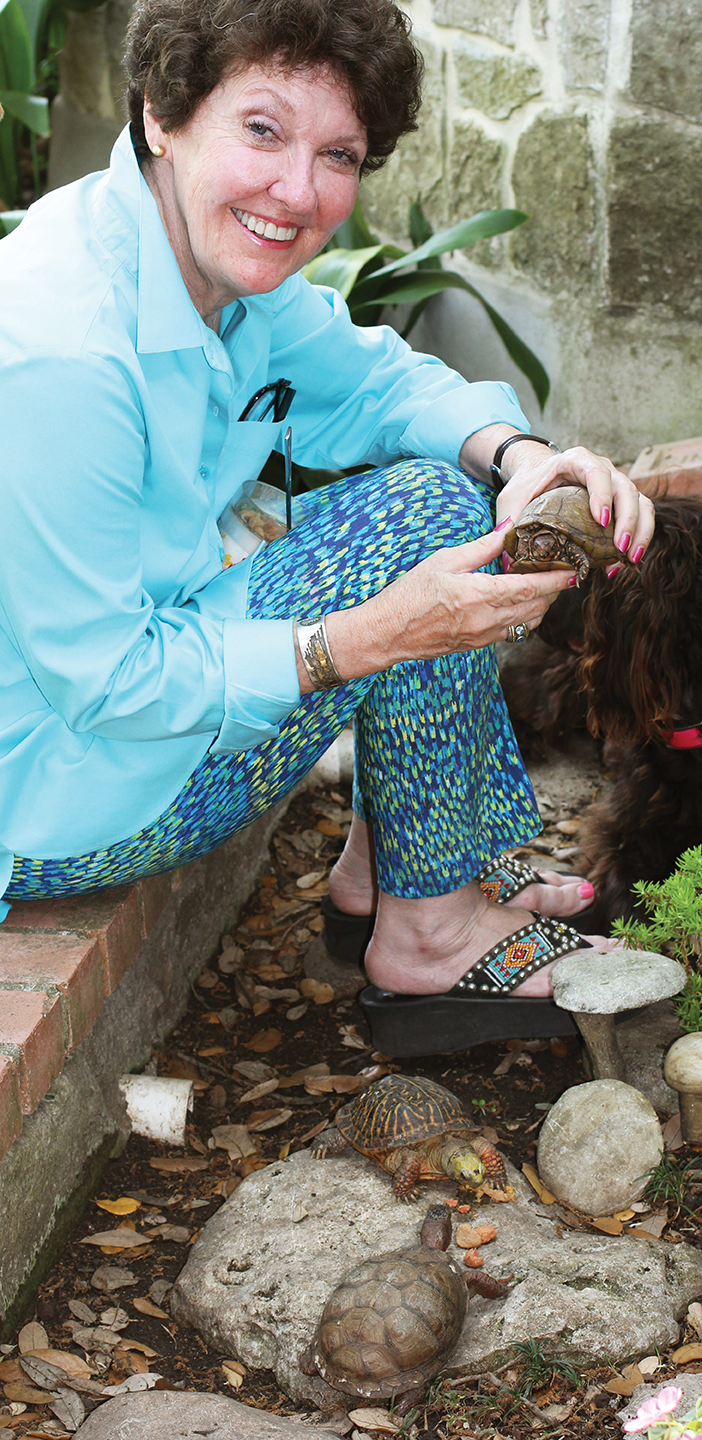While owning dogs can definitely be a delight and keeping cats, quite cool as well, for ‘09’s Rita Schimpff, its tending tortoises that she finds terrific. Yep, we’re talking about those carapaced characters that we’ve all seen cruising the outback and occasionally, our avenues too, proudly plodding along seemingly on some mysterious, but important to them, terrapin trek. And to Rita, always the nurturing naturalist, maintaining a diverse menagerie of these shelled sweethearts has become a life-long passion that’s included rescue, research and, when required, even rehabilitation.
Rita’s “love affair” with captive turtles began during her 78209 childhood when she was given a half-dollar-sized “pet store” red slider as a companion. And, she was quickly “smitten” by that little swimmer. It would be as an adult however before she acquired her first land tortoise and that story has its beginnings in a pet store too. As she recalls, “I was helping a friend who owned a pet shop when a salesman came in with a number of different animals. One happened to be a box turtle and, when it was discovered it only had one eye, the salesman figured that no one would want such a creature. Well, I shrieked when he said he would ‘dispose of it.” “One-Eyed Jack” subsequently went home with her that day and, is still going strong almost 40 years later. Now that’s longevity!
Today, one can find happily occupying Rita’s well-fenced, segmented backyard eight other box turtles (Ornate and Three-toed) and a rarer Yellow-Legged tortoise. Needless to say, Jack isn’t lonely with so much company. And, all owe their well-being to Rita and the expert care she daily lavishes on each and every one – whether it was a foundling, gift or a rescue.
But, is keeping a tortoise for everyone? Probably not since these special reptiles require a lot of (year-round) attention and understanding to thrive. For Rita, that wasn’t just providing a habitat but also entailed some extensive physiological research as well. For example, she discovered that, like all turtles, full-spectrum sunlight is essential. Without it (as a rule indoor lighting isn’t full-spectrum), the animal will suffer therefore Rita’s charges generally stay outside the majority of the year. And, the open-air venue can pose its own problems like the possibility of escape (these guys can dig and climb!) and exposure to predators like hawks, owls and especially, ravenous raccoons. Rita’s large dogs have proven to be the perfect guardians against hungry intruders however.
They also aren’t indestructible (think raccoons again). Over the years, Rita has had to nurse several who had been either injured or became ill. Thankfully, with the help of area vets and advice from some caretakers at the SA Zoo, she’s been successful in her rehabilitation efforts but a substantial personal commitment was required each time.
Fresh food is a concern too. Box turtles are omnivorous and, beside a strawberry or two, worms are thoroughly enjoyed. To this end, Rita maintains a couple of compost piles where the little ones are encouraged to personally forage for those delicious creepy-crawlies. And, like many other species, when winter hits (even in 78209), hibernation beckons. Rita prepares special containers for the tortoises to retreat into. When spring nears, she listens for their “scratching” which signals their desire to return to the outdoors again.
All in all, caring and keeping a tortoise (properly) can be a very rewarding experience. As Rita attests, “Believe it or not but each one of my ‘guests’ has his or her own personality – some are shy, others gregarious. And, they’re pretty smart too. When I call, they’ll even come to me.” (We all know some dogs and cats that won’t do that!). Couple the obedience with the undeniable fact that they’re really cute and, who wouldn’t mind sharing their ’09 digs with a tortoise or two. Just make sure that the species you adopt isn’t a legally protected one. Keeping those are not allowed!
By Ernie Altgelt







